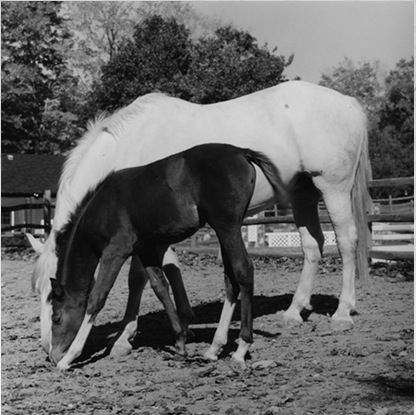
© Robert Mapplethorpe
Galerie Thaddaeus Ropac 7 rue Debelleyme 75003 Paris France
La galerie parisienne Thaddaeus Ropac accueille une sélection d'oeuvres de Robert Mapplethorpe choisies par Sofia Coppola. Un éclairage puissant et inattendu.
On peut choisir de donner ou non de l'importance au fait que Sofia Coppola ait elle même choisi les photographies de Robert Mapplethorpe exposées en ce moment à la galerie Thaddaeus Ropac à Paris, en allant les chercher à la fondation Mapplethorpe de New York ; les voir alors comme un storyboard en puissance, un tissu d'influences visuelles, un jeu de références (et la plus évidente d'entre elles, le panneau de l'hotel Château Marmont, décor de son dernier film, Somewhere).
D'elle-mêmes pourtant, les images de Mapplethorpe prendront vie sans qu'on ait besoin de les rapporter à l'aura sulfureuse du photographe ou au cool de la commissaire ; avec la même intensité et alors qu'il s'agit d'images méconnues de l'artiste, elles évoqueront les corps métallisés de la dernière série de Ryan McGinley (Life Adjustment Center) - notamment dans une image de bébé nu, de dos - les corps découpés entre soleil et ombre de Ralph Gibson, les fleurs figées de Karl Blossfeldt...
A l'image d'une enfant prostrée bras sur les genoux répond celle d'un petit chat, lové entre les coussins d'un canapé : et à travers ces dialogues à repérer transparaissent la sensibilité de Coppola, l'approche délicate et pastel qui caractérise ses films depuis Virgin Suicides. Une incroyable impression de silence aspire vers l'intérieur des images. Des femmes, Patti Smith en tête, plus loin Lisa Lyon sortie des eaux, affrontent la caméra, d'autres détournent le regard ; mais toujours ce flottement, cette désarticulation qui fait douter de l'emplacement de l'appareil et nous maintient en suspension. C'est probablement dans cet entre-deux visuel que se retrouve parfaitement S. Coppola, cette envie de montrer en sachant qu'on ira difficilement plus loin ; cet effleurement appliqué, et sensible.
Antoine Soubrier, le 15 décembre 2011.
Following collaborations with Robert Wilson and Hedi Slimane, Galerie Thaddaeus Ropac has invited Sofia Coppola to curate a new Robert Mapplethorpe exhibition.
This exhibition uses the same approach as the show “Robert Mapplethorpe: Eye to Eye”, which was curated by American artist Cindy Sherman in New York in 2003, and “Robert Mapplethorpe Curated by David Hockney”, which was presented in London in 2005. The idea is to have a contemporary artist bring his or her take on an œuvre as significant as that of Robert Mapplethorpe’s.
Celebrated American director Sofia Coppola selected the images from The Robert Mapplethorpe Foundation in New York—with whom the gallery has collaborated for this exhibition. By using rarely seen and little-known images taken by Mapplethorpe, Coppola has created an installation very much in step with her world. Always inspired by images, the director uses photographs to orient the visual concept of her films. She draws inspiration from images pulled from magazines, taken by iconic photographers, and even snapped with her own camera. Whether done consciously or not, from a single glimpse of the photographic ensemble, the viewer could easily imagine the photos to be a mood board for a future film. However, there is no “narrative” that weaves the selection of images together: the viewer has the freedom to invent fictional characters within the nuances of gray.
Sofia Coppola extracted gentle images from Robert Mapplethorpe’s archive: contemplative moments from which a delicate tension emerges. Known for his erotic and provocative images and the metaphysical nature he often imbues his subject matters with, the viewer is able to discover a nearly-unexplored side of the artist. Mapplethorpe’s portraits of children are taken with an intense gaze: Honey (1976), Andes (1979). He photographs animals languidly sprawled out: Muffin (1981), Kitten (1983). His portraits of charismatic women seize the intimacy of introspective moments: Annabelle’s Mother (1978), Paloma Picasso (1980). Mapplethorpe is also famous for his still life photographs of flowers. All of these stock-still people and things, replete with grace and candour, are presented through the gaze of a creative woman: Coppola’s innate sense of beauty is something she has in common with Robert Mapplethorpe. She knows how to emphasize, in the silence of suspended moments, the tenderness and emotion present in the artist’s work.
Sofia Coppola’s selection includes four loans from prestigious museums: Katherine Cebrian (1980) and Waves (1980) are part of the permanent collection of London’s Tate Modern, Melia Marden (1983) is part of the Guggenheim collection and Fireplace with Flowers (1986) belongs to the Montreal Museum of Fine Arts.


